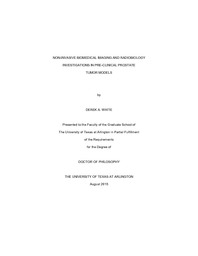| dc.description.abstract | Oxygen deficiency (hypoxia) in prostate tumors can hinder the biological effectiveness of radiotherapy. Therefore the ability to assess tumor hypoxia non-invasively in vivo in man could significantly improve therapy outcome. Magnetic resonance (MR) imaging is increasingly applied in clinical evaluation of prostate cancer. Therefore, an oxygen sensitive technique would be very attractive and the utility of oxygen-enhanced MRI (OE-MRI) has shown promise for predicting tumor growth delay in syngeneic rat prostate tumors following radiotherapy. In this dissertation, the overall goal was to investigate a potential imaging biomarker for predicting tumor response to image-guided radiotherapy (IGRT). First, I used in vivo bioluminescence imaging (BLI) and in vivo ultrasound (US) imaging as cancer screening tools to follow the growth of subcutaneous and orthotopic human PC3-luc xenografts in nude rats. Surprisingly in vivo BLI signals were inconsistent despite growing tumors as revealed by US, MR imaging, or mechanical calipers. Nonetheless, they were ultimately available for OE-MRI. Second, OE-MRI responses were acquired using a 4.7T small animal MR scanner in subcutaneous and orthotopic syngeneic Dunning R3327-AT1 and in orthotopic human PC3-luc xenografts. OE-MRI responses showed potential for stratifying animals based on their “apparent” oxygen status.Third, the rats with large AT1 tumors (tumor size ≥ 3 cm3) were exposed to either air or oxygen during a single dose of x-rays consisting of 30 Gy and the results indicated that their tumor growth delay correlated with ∆R1 and BOLD %∆SI suggesting stratification. However, no extra growth delay benefit was shown when inhaling oxygen during irradiation suggesting that the influence of hypoxic cells on tumor radiosensitivity remained a major factor. Fourth, I examined the influence of inhaling air or oxygen during a split-dose of x-rays with the same total dose of 30 Gy on small to intermediate (medium) sized tumors (0.5 cm3 ≥ tumor size ≤ 3 cm3). There were significant differences in the irradiated air or oxygen breathing groups and the unirradiated tumors. Inhaling oxygen during irradiation caused an increase in growth delay compared to inhaling air, suggesting a potential for modifying tumor hypoxia. Results showed significant correlations with tumor growth delay and pretherapy or between fraction OE-MRI responses. Increased OE-MRI responses after the first fraction of dose revealed tumor reoxygenation, which was confirmed by immunohistochemistry. Finally, a model for predicting tumor growth delay from split-dose fractionation was developed and validated. | en_US |

